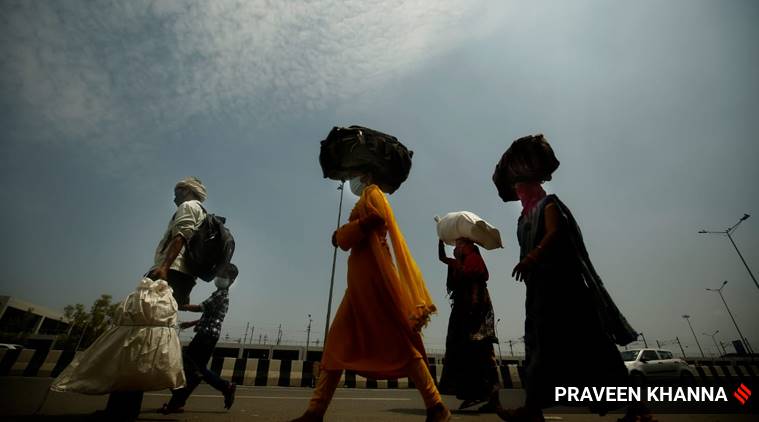- India
- International
Moody’s lowers India rating citing low growth prospects
Moody's expects India's real GDP growth rate to contract by 4 per cent in 2020-21 due to the shock from the coronavirus pandemic and related lockdown measures.
 Arun, a factory worker, walks with his family to board a bus from Ghaziabad to Kanpur on Saturday. (Express photo by Praveen Khanna)
Arun, a factory worker, walks with his family to board a bus from Ghaziabad to Kanpur on Saturday. (Express photo by Praveen Khanna)
RATINGS AGENCY Moody’s Investors Service on Monday downgraded India’s sovereign (foreign currency and local currency long-term issuer) ratings by a notch from Baa2 to Baa3, the lowest rating in investment grade, and maintained a negative outlook it had assigned last year.
In its statement, Moody’s said the action was taken in the context of the coronavirus pandemic, but was not driven by the pandemic’s impact. The decision reflects the agency’s view that the government would be challenged in enacting policies that mitigate the risks of sustained lower growth, sharp worsening of government finances, and stress in the financial sector.
The ratings agency cited slow reform momentum, constrained policy effectiveness and slower growth compared to India’s potential among the reasons for the downgrade. “…the pandemic amplifies vulnerabilities in India’s credit profile that were present and building prior to the shock,” Moody’s said.
Moody’s expects India’s real GDP growth rate to contract by 4 per cent in 2020-21 due to the shock from the coronavirus pandemic and related lockdown measures, but expects the economy to grow 8.7 per cent next financial year and closer to 6 per cent in the subsequent year.
Government officials said India’s debt sustainability metrics remained stable and internal estimates based on the country’s expected nominal rate of growth and borrowing costs suggested that “there is no worry” on that front. “As growth returns from FY21 onwards, our debt to GDP ratio should improve further,” a senior government official, who did not wish to be named, told The Indian Express.

The Finance Ministry did not reply to a mail seeking comments on the ratings downgrade.
“Thereafter and over the longer term, growth rates are likely to be materially lower than in the past, due to persistent weak private sector investment, tepid job creation and an impaired financial system. In turn, a prolonged period of slower growth may dampen the pace of improvements in living standards that would help support sustained higher investment growth and consumption,” it said.
India’s GDP growth slipped to an 11-year low of 4.2 per cent in 2019-20, while the fiscal deficit expanded to 4.6 per cent of the GDP as against the revised estimate of 3.8 per cent of GDP in the previous financial year.
Since Moody’s rating for India was one notch higher than S&P and Fitch Ratings, the market was expecting that it would be the first agency to lower its rating on India, bringing it at par with that of other agencies, banking industry sources said.
The ratings agency said while the government responded to the growth slowdown prior to the coronavirus outbreak with a series of domestic demand stimulating measures as well as the recent support package for vulnerable households and small businesses, it “does not expect that these measures will durably restore real GDP growth to rates around 8 per cent, which had seemed within reach just a few years ago.”
Stress in banking sector and non-bank financial institutions (NBFIs) weighs on growth dynamics through constrained supply of credit for consumption and investment, Moody’s said adding it did not expect the credit crunch in the country’s under-capitalised financial sector to be resolved quickly.
Also, fiscal constraints point to a higher debt burden for longer period of time as lower real and nominal GDP growth over the medium term will diminish the government’s ability to reduce its debt burden after a significant rise due to the coronavirus economic shock, it said.
Further, India’s large low-income population will limit the government’s tax revenue base as earlier prospects of a broadening of the tax base have not materialised, it said.
Among other emerging markets, Moody’s has downgraded sovereign credit ratings of Mexico and South Africa and maintained a negative outlook for these two countries, while it changed its outlook on Saudi Arabia to negative from stable. In case of Mexico and South Africa, Moody’s cited deteriorating fiscal strength and structurally very weak growth.
In case lowering of outlook for Saudi Arabia, it stressed on the downside risks to fiscal strength stemming from the severe shock to global oil demand and prices triggered by the coronavirus pandemic, and from the uncertainty regarding the degree to which the government can offset its oil revenue losses and stabilize its debt burden and assets in the medium term.
Moody’s said its upgrade of India’s ratings to Baa2 from Baa3 in November 2017 was based on the expectation that effective implementation of key reforms would strengthen the sovereign’s credit profile through a gradual but persistent improvement in economic, institutional and fiscal strength. However, implementation of these reforms since then has been “relatively weak” and has not resulted in material credit improvements, indicating limited policy effectiveness, it said.
As per Moody’s ratings scale, obligations rated Baa are termed to be medium-grade and subject to moderate credit risk and may possess certain speculative characteristics. Both Fitch Ratings and Standard & Poor’s have the lowest investment grade rating and stable outlook for India and any downgrade will now lead to junk status.
Apr 24: Latest News
- 01
- 02
- 03
- 04
- 05







































